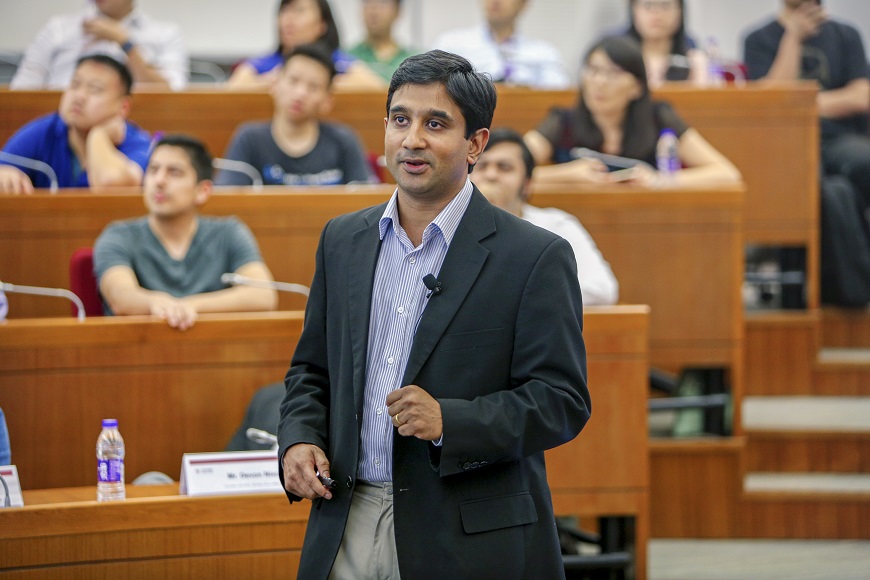How Capillary Won Over the China Market

As is well-known, China has a unique internet market landscape. With the online realm dominated by local giants such as Baidu, Alibaba and Tencent (BAT), some big-name foreign companies have failed miserably in their China adventures.
That said, some innovative businesses have managed to find their way in the China market. Among them is India-based Capillary Technologies, which racked up 200% China revenue growth in three years. What is the logic behind its trend-bucking success? Shameen Prashantham, Associate Professor of International Business and Strategy at CEIBS, provides the answers.
1. The goal: Build a “cool” company
In 2008, Indians Aneesh Reddy and Krishna Mehra quit their jobs and planned to start a business. Their initial idea was simple: to build a “cool” company.
“We didn't have a million-dollar idea when we began working. We picked two sectors which were doing well and worked on something in between them. The obvious ones were retail and mobile,” Reddy explained.
The two founders did some research on India’s retail sector. They found a lack of license-based, locally-deployed retail CRM (customer relationship management) software on the market. Offline retailers suffered from plunging sales and low repurchase rates, as they could not have full insight into customers, nor could they interact effectively with existing clients.
To address this pain point, Reddy and Mehra decided to offer an affordable, simple retail CRM software service to help retailers collect data on each customer.
CRM referred to a management philosophy that aimed to create, develop, and enhance customer relationships to maximize customer value, corporate profitability, and ultimately the shareholder's value. When people talked about CRM, they usually referred to CRM software used to manage organizational interactions with customers. CRM enabled organizations to gain actionable insights using a back-end analytical engine, find new opportunities with predictive analytics, streamline the operations, and personalize customer services based on a client’s interaction history.
Based on Gartner estimates, by 2022, 70% of customer interactions would involve some form of emerging technology such as machine learning, internet of things, location-based services, and mobile messaging. This was up from 15% in 2018. However, most companies were unable to deal with these cutting-edge technologies or develop a mature CRM system on their own. Therefore, the demand for professional CRM solutions exploded.
Capillary was established in June 2008. Unlike other start-ups that had trouble accessing funding, Capillary got support from 17 angel investors and those funds kept them going for three-and-a-half years.
The company first developed an analytics product, and then launched a digital campaign tool. During the first three years, Capillary focused on India and other emerging markets. Its solutions needed no new terminals, servers, or customized implementations. It was very easy to deploy and available on an affordable pay-as-you-go monthly pricing model without upfront licensing fees. Using its tools, retailers could identify customers by mobile-phone numbers, track their behaviour, better understand their attributes, and offer them personalized products and services (e.g. suggesting customers shopping for shirts take advantage of instant discounts on pants).
“The typical impact of our solution to a retailer is an increase of 5 to 6 percent in sales,” Reddy said. So Capillary was well received by emerging markets, and the number of retail stores it served increased rapidly, to about 4,000.
Capillary scaled up by focusing on product upgrading and business expansion alongside CRM. Adequate resources played a critical role in the process and the company continued to successfully access funding with capital injections in 2012, 2014 and 2015.
Eventually, industry trends meant Capillary had to evolve into an Omni-channel CRM provider by adding online offerings to the strong portfolio of cloud-based software for offline retail stores it already had, and offering a suite of integrated products for Omni-channel operations. To quickly access related technologies, Capillary complemented R&D with acquisitions. Reddy explained, “As validation for a new product line takes close to 12-18 months, it was reasonable to go for an acquisition.”
Capillary had sufficient money to burn thanks to three rounds of successful financing. Through a mix of acquisitions and in-house R&D initiatives, the company successfully transformed into a true Omni-channel SaaS CRM provider. Its business grew to include e-commerce, artificial intelligence, and machine learning, while retaining its original work with CRM, and covered almost every service for Omni-channel CRM. By 2017, from 11 global offices its 700 plus employees served over 25,000 stores across 30 countries, with clients including more than 300 brands such as Wal-Mart, VF Group, Starbucks, Unilever, KFC, and Pizza Hut.
2. Beyond Asia & back
In 2011, Capillary shifted its focus to markets outside of Asia. The reason: the company believed local retailers around the world, including in developed countries, faced similar pain points for which they could provide solutions.
Capillary relocated its headquarters to Singapore in 2012 and during the years that followed set up offices in the US, Europe, the Middle East and a few more countries. By 2015, Capillary’s software had served over 150 million customers and processed about US$8 billion in gross merchandise volume, or about 500,000 transactions per day across the world.
But at the end of 2015, Capillary decided to once again make Asian markets its focus.
There were two reasons for the decision.
First, Capillary found that Western and Asian retailers had very different styles when purchasing technology.
Second, Capillary realized that Asian markets were growing rapidly. As a small company, Capillary knew it would be best to focus, instead of spreading itself and its resources thin.
Reddy explained, “Asia is a big market. The 11-12 countries where we are focusing on is an around US$2.5 billion play. There are 6,000 large retail players with whom we can engage and we are probably at 1-2% of that now.”
That also meant many of their competitors also had their eyes on the market, including world-leading CRM providers such as IBM, SAP, Salesforce and Oracle. But compared to these established players, Capillary believed it had three things in its favour:
First, with their roots in developed countries, these big companies did not do enough work on localization. Capillary claimed it could complete projects 2-3 times faster.
Second, Capillary’s products were cost-saving and easier to implement, and by integrating all its services into a single platform, the company saved customers, especially SMEs, the trouble of purchasing multiple software licenses.
Third, as an Asian company Capillary had a better understanding of local markets so it could build products better suited to clients’ needs.
3. Entering China
In mid-2015, Capillary decided to focus on four major Asian markets — India, China, Southeast Asia and the Middle East, where they believed there was huge potential.
Amit Haralalka started to learn Mandarin in 2013, long before he landed in China to lead the company’s Chinese team. He sees his China journey as a fateful coincidence.
Capillary China was incorporated in Shanghai in August 2015, with only four employees (two from India, one each from Singapore and China). Amit said the company faced three challenges back then:
First, lack of a familiar ecosystems such as Google or Facebook. This meant Capillary had to adjust to accommodate the reality on the ground.
Second, China had different language needs and a unique culture.
The third related to perception. As China was still a relatively closed economy, outsiders believed the Chinese people were also culturally closed-minded and unwilling to do business with foreigners. There were many cases of foreign companies that had failed in China. So Capillary had to work extra hard to convince customers, investors and internal teams each time they wanted to invest in the country.
Capillary’s first customer in China was not a local Chinese company, but a multinational corporation (MNC) with business in China, the VF Group. Its brands included Lee, Nautica, North Face and Kipling.
In 2014, after a one-year evaluation of the company, VF picked Capillary over two big international names, even though Capillary did not even have an office in China.
It began by having Capillary handle CRM for Kipling, VF’s smallest brand. Capillary eventually won VF’s trust and was rewarded with business from four other VF brands, including its flagship North Face brand.
Similarly, Capillary slowly built up its clientele to include large foreign retailers such as Pizza Hut, Combi, Harley-Davidson and Kolon Sport.

4. Hard work pays
In 2018, local Chinese clients accounted for nearly 40% of Capillary’s China business, but this was not achieved overnight. Capillary worked hard to adapt to the Chinese market.
Capillary recognized that China’s technology ecosystem is unique. BAT, rather than Google, Facebook and Amazon, are the country’s giants. So in July 2016 Capillary launched a WeChat-based social CRM software, its first product customized for the Chinese market. This put the company a step ahead of the competition.
At that time, there were more than 700 million WeChat monthly active users. Capillary’s CRM software helped brands enhance their engagement with customers, provide customer’s transaction history with the brands, and allow location tracking that let consumers find the brands’ nearest store.
The product was embraced by Capillary’s Chinese customers. The company had successfully completed its first attempt at “product-market” fit in the China market.
The product was not developed by Capillary’s Chinese team, and despite its success the company soon realized the importance of having a local tech team. GXG was Capillary’s first local Chinese customer but their collaboration, which began in 2016, only lasted for a few months. Capillary’s global technology team alone was not enough to meet the needs of a local customer. In the same year that the GXG deal was unravelling, Capillary signed a contract with another Chinese customer and it could not afford another failure. Meanwhile, Tmall, the largest B2C platform in China, began to open up its platform and customer data to brands, suggesting more CRM localization needs ahead.
In early 2017, Capillary started to build a Chinese technology team. At its customers’ request, Capillary developed CRM solutions for Tmall’s O2O model that July, making it one of the first few firms to offer such CRM solutions. Based on the Chinese reality, Capillary also adjusted other offerings, such as offline InStore services.
Capillary did what it could to understand China’s customers and business environment. Amit noted some cultural differences between China and other countries:
First, in their interaction with brands via digital touch points, Chinese customers had very high expectations of service quality. So everything must work perfectly and be user-friendly.
Second, many Chinese consumers liked playing games, such as lucky draws. Compared to easy-to-get discounts or rewards, they preferred good deals that took some effort to obtain.
Third, Chinese are more willing to share data with brands and retailers in exchange for a more personalized experience. Capillary incorporated these observations in its product designs and helped brands better interact with their Chinese clients.
The company also had the added advantage of being able, unlike most Chinese CRM service providers, to offer comprehensive, integrated services for all platforms — a truly Omni-channel strategy. As a wholly-owned foreign enterprise, Capillary was not obligated to work with any specific local platform and could cooperate with them all.
Though it adapted to local market conditions, Capillary never strayed from its core belief in providing high-quality, high-priced, and SaaS-only solutions for customers’ long-term interests, rather than competing through low-cost and on-premise solutions to meet their short-term needs.
Its target customers were large retailers, including many big Chinese names such as Anta, En Yan Sang and Xtep.
Amit summed up his experience this way, ““If one really sticks to the basic principles, doing business in China is not any different from anywhere else.”
5. Focus: China market
Capillary’s China revenues increased by a dramatic 200% each year, reaching about US$2 million by early 2018. That year, given the Chinese market’s rapid growth, Capillary decided to make it the focus of its investments with the expectation that revenues would double in the next fiscal year.
Amit noted: “Online business [accounted for] 20% of the total retailing revenue in China, while the number in other countries was only about 5%. China must be the highest potential market.”
He summarized the three key advantages of Capillary’s China expansion:
First, Capillary benefitted from its focus on one vertical market segment (retail industry) and one particular geographical area (Asia). This paved the way for the company to become highly proficient in retail CRM and have a deep understanding of the needs of local retailers. In addition, it made the China market its top priority.
Second, unlike many of its local competitors, Capillary was not financially dependent on China’s tech giants (BAT).
Third, Capillary had a technological edge. The company had built a 200-member global tech team plus another one made up of Chinese staff. And while most of its Chinese competitors began with online business, Capillary’s core technology, developed a decade earlier, was built for offline retailers — a much more challenging undertaking. This gave the company an edge as “new retail” emerged as a major trend within China.
But with all its success, Capillary still faced many challenges. The China market still contributed the smallest share of the company’s total revenue. And there were pros and cons that came with the rise of “new retail”. These included more customer conversion as well as more new requirements for CRM vendors, along with increased competition. Capillary was trying to have a deeper understanding of China and deepen its presence in the Chinese market. The company’s goal: to become a leader in China’s CRM market by 2020
As Amit said, “There is a lot more to learn, and a lot more to do.”
Takeaways:

From this case we see the importance of a learning orientation while internationalizing. While Capillary still has a long way to go, its initial results in the Chinese market – which is large, complex and rather unique in terms of the dominant ecosystems – are positive. In summary, success comes from focus, persistence and wise adjustments to strategy.
Three inter-related principles that we can learn from Capillary are:
- (1) Take advantage of existing customer relationships – but don’t stop there. There is value in client followership – that is, working with multinational clients across different markets – in terms of providing a useful start in a new market. But this alone may not be a sustainable solution. Building local client relationships is very important.
- (2) Localize in terms of technology and talent. This will help to develop a deep understanding of the specific challenges and opportunities in the local market. It is important for leaders of an international company to show commitment to the local market. Amit Haralalka has been demonstrating this by learning Chinese (he recently passed the HSK level 4 exam) and has built a local technology team.
- (3) Leverage a wide range of network relationships. Although not explicitly discussed in the case, Amit tapped the growing community of India-origin people in Shanghai (although this is very small compared to other locations such as the US, UK and the Middle East). Also, in addition to tapping into its former customer relationships, Capillary was also able to tap its investor ties, and had informal discussions with other startups from its investors’ portfolio who had a presence in China, getting useful tips from them.
I thank the CEO of Capillary Technology, Aneesh Reddy, and the China GM Amit Haralalka for cooperating with CEIBS on this case study. I also thank Dr Livia Ruan, CEIBS case writer, for her work on this case.













